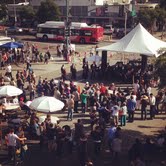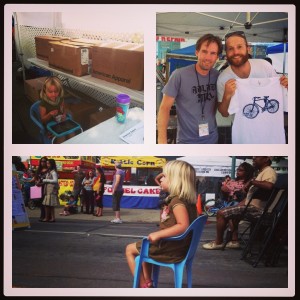 I love my neighborhood. It’s not that it is all that glamorous or cool or “safe” or whatever. It’s that it is full of people who actually want to experience some kind of community together. There is a building sense that we all have some skin in the game and that our thriving is somehow connected to the thriving of our neighbor. Whether talking with fellow parents at the park, young students at the dive bar or our friends in the local Mexican bakery, words like community, neighborhood and integration seem to be finding their way into our everyday vocabulary of conversation.
I love my neighborhood. It’s not that it is all that glamorous or cool or “safe” or whatever. It’s that it is full of people who actually want to experience some kind of community together. There is a building sense that we all have some skin in the game and that our thriving is somehow connected to the thriving of our neighbor. Whether talking with fellow parents at the park, young students at the dive bar or our friends in the local Mexican bakery, words like community, neighborhood and integration seem to be finding their way into our everyday vocabulary of conversation.
It’s not always been this way in Golden Hill.
It wasn’t too long ago that our neighborhood was known as “Heroin Hill” because of the drug presence and violent activities that regularly surrounded it.
Before that, it was known as the “Garbage Dump” because our numerous recovery homes would house societies “garbage.”
Well, there is a new narrative bubbling to the surface on our streets, storefronts and in our homes. It is a narrative of new life, renewed hope and a common vision for a shared future.
Just two weeks ago, we had our second annual Golden Hill Street Fair. The same streets that have endured years of crime, segregation and hopelessness began to spring to life. This early Sunday morning, like a garden showing its first signs of germination, 25th street (which is right outside our front door) started sprouting to life as tent after tent took their place. Stages were being set up and the smell of a dozen different ethnic foods began to fill the air. The beer garden was taking shape as three local breweries brought out their finest, and resident volunteers were running a million miles a minute, the majority of whom had huge smiles on their faces.
The anticipation was palpable.
And then people started streaming in. By noon, there had probably already been about 5,000 people that had come through and by the end of the day, close to 20,000.
20,000 people. That’s more than our neighborhood’s total population.
 I volunteered to work the event (with my 3 year old by my side watching Dora the Explorer and dancing to the mariachi bands) selling customized Golden Hill t-shirts. As the line grew with each passing hour, I realized something about my neighbors and the neighborhood we share. Golden Hill was receiving a new identity. No longer a place to be ashamed of or viewed only as a holding area until we could afford to live some place better, our neighbors were proud of our neighborhood. Not because our real estate values went up or because our crime levels had dropped, but because we were sensing the type of community humanity is designed for.
I volunteered to work the event (with my 3 year old by my side watching Dora the Explorer and dancing to the mariachi bands) selling customized Golden Hill t-shirts. As the line grew with each passing hour, I realized something about my neighbors and the neighborhood we share. Golden Hill was receiving a new identity. No longer a place to be ashamed of or viewed only as a holding area until we could afford to live some place better, our neighbors were proud of our neighborhood. Not because our real estate values went up or because our crime levels had dropped, but because we were sensing the type of community humanity is designed for.
We were moving towards a common good together and that made the impossible seem possible. These types of spaces encourage the lonely widow to experience the joy of new life. They allow the single mother to realize they aren’t alone. They create space for isolated families to engage with one another and dream about shared life.
For a number of years now, I have been apart of a community of about 30 people who all live in Golden Hill seeking to stumble towards Jesus together. We don’t have it all figured out, but we deeply care for our neighbors and our neighborhood in general. Between all of us, we have established hundreds of relationships within these 7 X 10 blocks. Over the course of the day, I saw nearly every person we have experienced life with over the years. From a distant acquaintance to a dear friend. From the liquor storeowner to my community league basketball buddy. From my farmer’s market colleagues, to local pastor friends.
Within each interaction, there was a common spark in our eyes. A spark of celebration of what has been unfolding and anticipation for what is to come.
Having helped start our neighborhood Farmer’s Market a few years ago and now finishing my first full year on the board of our Neighborhood Council, my perspective on what is unfolding in my neighborhood is much different than at any other time in my life. These kinds of Kingdom moments don’t just happen randomly. They are not moments we can simply sit back and hope create themselves. No, these are sacred moments the Community of God is called to be right in the middle of.
Here are some ways we can begin to engage our neighborhoods redemptively and link arms with others for the common good:
1. Stop spending so much time at church
Before you walk me down the Plank ‘O Heresy, here me out. I’m not saying we stop gathering as the Church. No, no, no. What I am saying is that, 1. It is easy for Christians to think the best ministry happens at a church building. As a result, we get so busy going to a building (that usually is not in our neighborhood) to do ministry, that we don’t have any time to share life with those right outside our front door. In the words of my friend, Jer Swigart, “We can live in our neighborhoods without actually ever living life within it.” 2. See your neighborhood as your local parish. These are the people you have been called to live, love and lead alongside. Having hosted many formal church sponsored events in my day, I can’t tell you how freeing and transformative it was to help host an event that wasn’t put on by a church, but could be intimately engaged by the Church. People don’t know me as “Jon the Pastor,” but as Jon the dude who plays basketball in the rec center or Jon the guy who works at the farmers market or Jon on the Neighborhood Council. We don’t have to have a “Christian” title to do ministry. In fact, those titles can often be the greatest hindrance.
2. Identify the assets in your neighborhood
What does your neighborhood already have to offer that you can simply come alongside and support? We don’t need to start our own “Christian” version of things, we simply need to follow Jesus into the places he already is at work and join him there. What are the public spaces where your neighbors already gather? Join your local sports leagues, take your kids to the same park everyday, shop at the same businesses, build relationships at the local pub/bar/coffee shop, support the local church in your neighborhood (even if you don’t like the preaching or music or whatever), etc…
3. Connect with influencers in your neighborhood
Whether they are long time residents, business leaders, local politicians or artist, there are people who carry a lot of influence in your neighborhood. Seek them out and take them to coffee. You will be surprised at how thrilled they will be to hear of your common heart for your neighborhood and begin to form a collaborative relationship. They will give you access to people and systems that would take you years on your own.
4. Immerse yourself in the areas of brokenness
We are taught to only see either what is right in front of us or what is pleasing to the eye. If we are to follow Jesus into our neighborhoods, we must be agents of reconciliation. This means we have to intentionally walk off the beaten paths and see what is happening below the surface that is in need of healing. This may be a hidden population in your neighborhood who is either being oppressed/forgotten (whether intentionally or not), a political or economic injustice or a sociological reality like isolation, depression or workaholism. These must take a human face. Immersing isn’t simply identifying a problem, but entering into it redemptively (think Incarnation).
5. Contend for the broken to the point of restoration.
Jesus followers are to live in the reality of Resurrection. Even though things may look impossible and the hope of New Creation far off, we must remain in the game even when things get tough. While things will not always end how we’d hope, we are to walk with people and systems with a vision for restoration. The Good Samaritan didn’t put a Band-Aid on the broken down pilgrim and walk away. No, he walked him, sacrificing his own good to the point of restoring the pilgrim back to community. This is where most of us want to jump ship, but this is where the world needs us most.
In the late 1800’s a poet had a vision for my neighborhood beyond what most could see at that time. It is a picture that lifts our site line from a broken past and gives us a glimpse of a hopeful future.
As the sun rolls down and is lost to sight,
Tinting the scene with its golden light,
The Islands dim and the fading shore,
The ebbing tide through our harbor door,
The drooping sails of an anchoring fleet,
The shadowy city at our feet,
With the Mountains’ proud peaks so lofty and still,
‘Tis a picture worth seeing, from Golden Hill.
For the summer of 2014 I am living in San Diego near San Diego State in an interfaith community called the Enchanted Garden. I am also attending the San Diego First Church of the Brethren, and getting involved with the City Heights neighborhood. I want to connect with you all, learn from you, and see if I can somehow find a mentor who can help me support City Heights in being all that God wants it to be. I also want to apply all that I learn in Fayetteville, Arkansas, where I live. I hope you can contact me–otherwise I will be looking for you at the Farmer’s Market or on the basket ball court:)
B